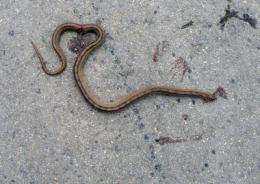The majority of roadkill amongst vertebrates in Catalonia are in protected areas

Amphibians are the vertebrate group that is more likely to become roadkill in Catalonia, even more so than reptiles, mammals and birds. This is the case according to an international team of scientists who have concluded that highly protected areas are home to more cases of animal death on the roads.
Our network of roads is considered one of the main threats to fauna survival. Researchers at the universities of Barcelona (UB), Porto (Portugal) and Uppsala (Sweden) have studied the number of vertebrate deaths on 820 kilometres of road in North Eastern area of Spain and Portugal.
"The project consisted of analysing the impact of the road network on fauna, leading to numerous studies across the whole of Catalonia to record all specimens of roadkill found," as explained to SINC by Núria Garriga, researcher at the UB and lead author of the study headed by Gustavo A. Llorente, a scientist at the same university.
Field work was published in the 'Biodiversity and Conservation' journal and was carried out over four years on 41 secondary roads in Catalonia. Some 20 km of each road were inspected during summer and autumn. As Garriga points out, "there are few studies on an international level that have carried out such an extensive research and sampling."
Nature reserves like Parc Natural dels Aiguamolls de l'Empordà, Parc del Garraf, Parc Natural de la Zona Volcànica de la Garrotxa, Parc Natural de Sant Llorenç del Munt i l'Obac and Parc Natural del Montseny.
"We got in a slow moving car to collect data. When we spotted a dead animal we would stop, make a record and note down the species. We also took down other significant information like surrounding vegetation and the closest water points," outlines the researcher.
One of the main conclusions of the study was that amphibians are more likely to become roadkill and that roads within nature reserves and natural parks are home to the highest number of animal road deaths.
"This could be explained by the fact that protected areas frequently receive a high number of visitors, which in turn increases the flow of traffic in places that are teaming with wild life," ensures the researcher.
According to the experts, to decrease amphibian death we would have to build special passages for them in high-risk areas. These come in the form of tunnels under the road designed to allow the passage of animals.
The team is currently working to identify hotspots. They therefore inspected seven roads throughout an entire year to define the most dangerous areas and protect them.
References:
Núria Garriga, Xavier Santos, Albert Montori, Alex Richter-Boix, Marc Franch, Gustavo A. Llorente. "Are protected areas truly protected? The impact of road traffic on vertebrate fauna" Biodiversity and Conservation 21: 2761. DOI 10.1007/s10531-012-0332-0.
More information: Biodiversity and Conservation 21: 2761. DOI: 10.1007/s10531-012-0332-0
















